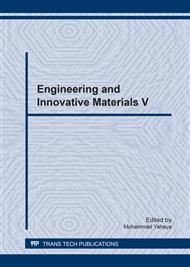p.3
p.9
p.14
p.19
p.25
p.30
p.36
p.45
Development Approach of Asbestos-Free Friction Material Using Flyash Particles
Abstract:
In the present work, the development of flyash-based friction composites for replacing asbestos material was systematically proposed. In order to solve the high-testing cost and time consuming problem in design formulation process, the mechanical properties of composites were first investigated with regarding to the contents of phenolic resin, friction modifiers and aramid fibers. Friction performances were continually tested with the samples optimized mechanical properties. When considering the results of mechanical testing, it was observed that the elastic modulus and compressive strength decreased with increasing resin fractions in the corresponding test ranges. On the other hand, an addition of friction modifiers and fiber contents can be contributed the mechanical strength. In the friction performance results, an addition of 2.5 wt% fibers showed enhancing of friction coefficient and decreasing of wear resistance at elevated temperature ranges of 100 oC to 200°C. Conversely, the composite filled with 5.0 wt% aramid fiber presented the stability of friction efficient in ranges of 0.56-0.57 and also gave better wear resistance lower than 0.39×10-7 cm3/N.m.
Info:
Periodical:
Pages:
19-24
Citation:
Online since:
March 2017
Authors:
Keywords:
Price:
Сopyright:
© 2017 Trans Tech Publications Ltd. All Rights Reserved
Share:
Citation:


